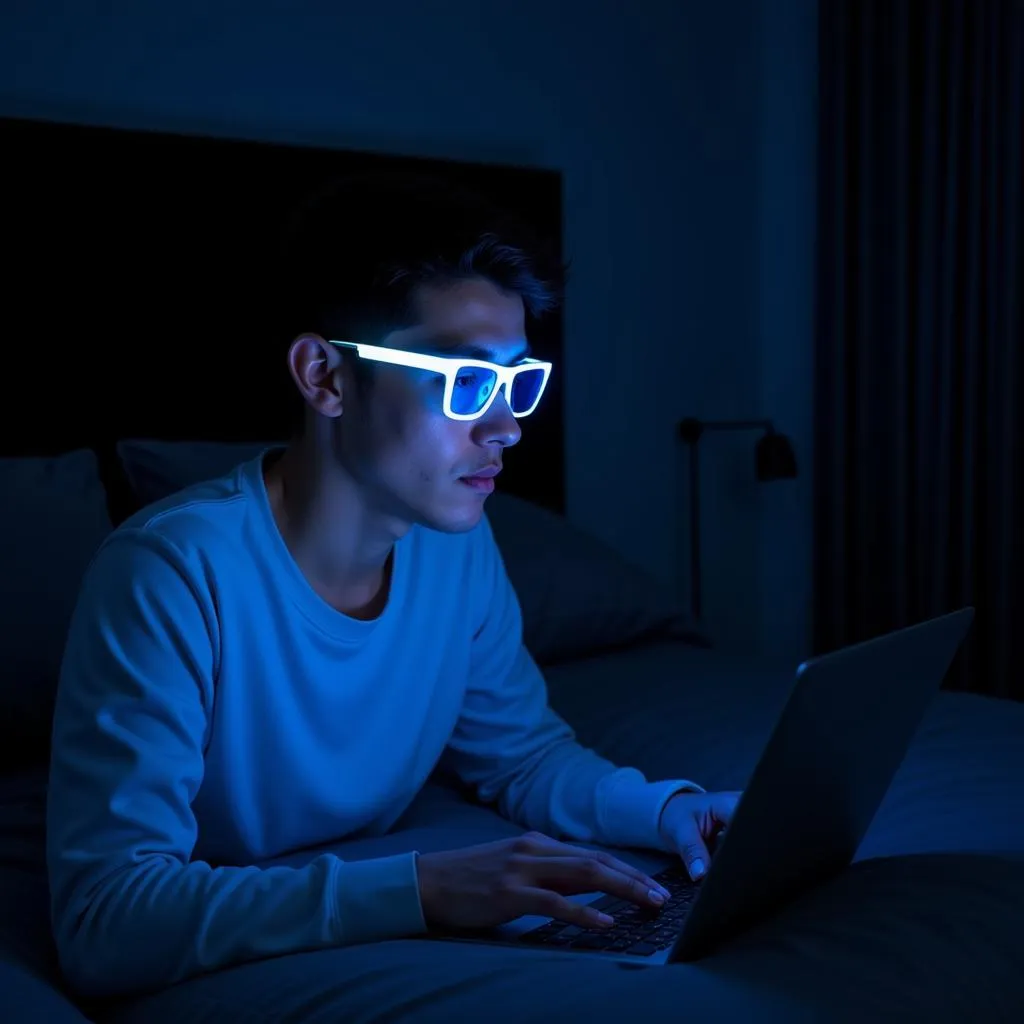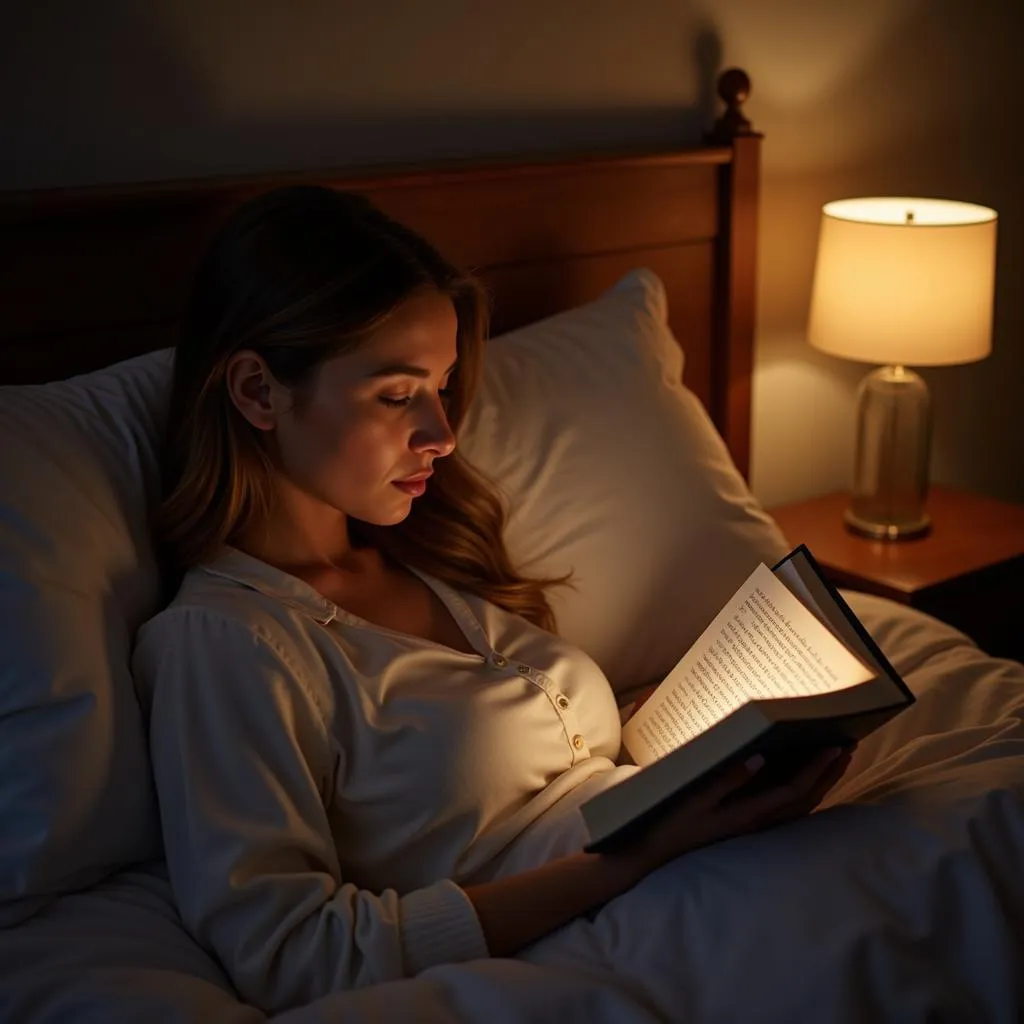Choosing the right lighting for your bedroom can significantly impact your sleep quality. While you might have already heard that harsh blue light is a sleep disruptor, did you know that certain LED colors can actually promote better sleep? Let’s explore the world of LED color and find the best hue to transform your bedroom into a sleep sanctuary.
Understanding the Science of Light and Sleep
Our bodies operate on a natural sleep-wake cycle called the circadian rhythm. This internal clock is heavily influenced by light exposure. When your eyes detect light, they send signals to your brain, which in turn regulates the production of melatonin, the sleep hormone.
 Person wearing blue light blocking glasses while working on laptop
Person wearing blue light blocking glasses while working on laptop
Blue light, abundantly emitted from the sun and electronic devices, effectively suppresses melatonin production, signaling to your body that it’s time to be awake. Conversely, warmer colors like reds and oranges have a minimal impact on melatonin, making them ideal for promoting relaxation in the evening.
What Is the Best LED Light Color to Sleep With?
When it comes to choosing the best LED light color for sleep, red LED lights emerge as the clear winner. Red light has the least power to shift your circadian rhythm and suppress melatonin. This means that exposure to red light in the evenings is less likely to disrupt your sleep cycle.
While red might not be your first choice for bedroom decor, you can opt for warm white or amber LED lights for a more visually appealing option. These colors fall on the warmer end of the spectrum and mimic the soft glow of candlelight, creating a cozy and relaxing ambiance conducive to sleep.
Other Colors to Consider
While red, warm white, and amber are considered the most sleep-friendly LED colors, let’s explore the effects of other colors on sleep:
- Blue Light: As mentioned earlier, blue light, while beneficial during the day for alertness, is best avoided in the hours leading up to bedtime.
- Green Light: Some studies suggest that green light might have a calming effect and could potentially promote sleep, but more research is needed.
- Yellow Light: Similar to green light, yellow light is thought to be relatively relaxing, but it’s not as extensively studied as red light for sleep benefits.
Tips for Creating a Sleep-Friendly Bedroom
- Choose the Right LED Bulbs: Opt for bulbs with a color temperature of 2700K or lower for a warm and relaxing glow.
- Use Dimmable Lights: Being able to control the brightness of your lights allows you to create the perfect ambiance for winding down.
- Minimize Blue Light Exposure: Reduce your exposure to electronic devices at least an hour before bed. If you must use them, consider blue light blocking glasses or apps.
- Create a Relaxing Bedtime Routine: Engage in calming activities like taking a warm bath, reading a book, or listening to soothing music.
 Woman reading a book in bed with a warm-toned lamp on
Woman reading a book in bed with a warm-toned lamp on
Conclusion
Incorporating sleep-promoting LED lighting into your bedroom can make a significant difference in the quality of your sleep. By understanding the relationship between light and sleep and making conscious choices about the colors you bring into your sleep environment, you can create a haven for restful nights and energized mornings. If you need help choosing the right LED lights or want to explore other ways to enhance your sleep, don’t hesitate to contact us. We are here to help you create the perfect sleep sanctuary.
FAQs
Q1: Can I use regular white LED lights in my bedroom?
While regular white LED lights are fine for general lighting, they might not be the best choice for your bedroom if you’re aiming for optimal sleep. Opt for warmer white LEDs (2700K or lower) to minimize blue light exposure.
Q2: Do I need to switch all the lights in my house to red?
No, you don’t need to change all the lights in your house. Focus on creating a relaxing and sleep-conducive environment in your bedroom.
Q3: How long does it take for LED lights to impact sleep?
The impact of LED lights on sleep varies from person to person. However, it’s generally recommended to limit exposure to blue light for at least an hour or two before bed.
Need more guidance on colors? Explore our articles on what color candle is for healing and what color of.
Looking to create a calming ambiance in other areas of your home? Find out what color goes with sage.
For immediate assistance, contact us at:
Phone: 0373298888
Email: SEO.backlink@gmail.com
Address: 86 Cầu Giấy, Hà Nội
Our customer support team is available 24/7 to answer all your queries.

